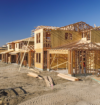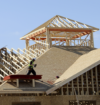Construction data for the Southern U.S. showed significant declines in September, with activity slowing across most categories. The dip marked a return to levels not seen since the early stages of the pandemic, underscoring the ongoing challenges in the housing sector.
- Building Permits: The South issued building permits at a seasonally adjusted annual rate of 765,000 in September, a 6.1% decline from August. This is the lowest level for permits since July 2020.
- Housing Starts: Housing starts fell to a seasonally adjusted annual rate of 738,000 in September, down 3.4% from August. This is the weakest level since May.
- Housing Completions: The most significant drop was seen in housing completions, which fell to a seasonally adjusted annual rate of 857,000 in September—a staggering 21.6% drop from the 1.09 million rate in August. This marks the lowest completion rate since March.
Small Silver Lining: Amid the broader downturn, single-family housing starts emerged as a positive note. These starts jumped to a seasonally adjusted annual rate of 601,000 in September, representing a 6.5% increase from August. This was the highest level for single-family starts since April.
- Despite the improvement in single-family starts, other aspects of the housing market continued to face headwinds. Building permits for single-family homes dropped 4.0%, while completions fell by 5.3% from August levels.
Still The Leader: Despite the decline, the South continues to lead in every major construction category. The region accounts for 53.6% of all building permits, 54.5% of all housing starts, and 51% of all housing completions nationwide. While these figures have decreased from their peak, they underscore the South’s sustained dominance in the housing market, even as demand begins to slow.
Bottom Line: September’s data reveals a complex landscape for the Southern housing market. While the South remains a leader in residential construction across all categories, its advantage is narrowing due to rising affordability challenges, with home prices climbing and interest rates staying high. The region’s future growth will hinge on how builders navigate changing demand and evolving economic conditions.



